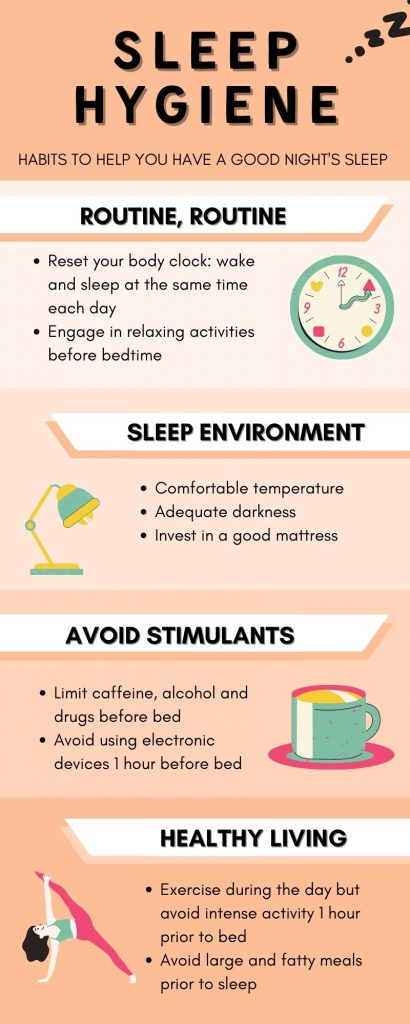As the weather gets warmer and we get busier, you may forget to eat or to eat only what’s convenient. This can mean less nutritious, healthy meals. With Spring right around the corner, what better time to enjoy fresh vegetables. Take the guesswork out of your meal planning and try one of these vibrant recipes:
Month: March 2022
Daylight Saving Time and Sleep Hygiene

Daylight saving time (DST) begins again on Sunday, March 13, 2022, when most Americans will spring forward an hour at 2 a.m. local time. Clocks won’t be moved back until Nov. 6, when daylight saving time ends for the year. These fall and spring time changes continue a long tradition started by Benjamin Franklin to conserve energy in 1784. By moving clocks forward, people could take advantage of the extra evening daylight rather than wasting energy on lighting. Even so, DST didn’t officially begin until more than a century later when. Germany established it in May 1916, as a way to conserve fuel during World War I. The rest of Europe came onboard shortly thereafter and in 1918, the United States adopted daylight saving time. A year later it was abolished and then eventually reinstated giving states the choice as to whether they wanted to participate and when they wanted to change their clocks. This led to a lot of confusion and in 1966 Congress passed the Uniform Time Act. This Act still allowed states the choice to participate in daylight saving time, but set a consistent national protocol for DST. Then, in 2007, the Energy Policy Act of 2005 went into effect, expanding the length of daylight saving time to the present timing: DST begins the second Sunday in March and ends on the first Sunday in November.
Whether or not the practice actually shrinks energy bills seems to vary from state to state and remains up for debate today. What seems more certain, however, is that the subtle time shift can take a noticeable toll on the human body. Some researchers have found there are more car accidents and work injuries when daylight saving time begins due to decreased sleep and alertness. Others have linked the changes in circadian rhythm to increases in the number of heart attacks and headache clusters. The bottom line is that getting consistent and good sleep is vital to good health. Here are some tips to avoid the grogginess as the time-change approaches:
- A few days before Daylight Saving kicks in, hit the sack a little earlier each night. Even 15 minutes earlier for three days can make a difference.
- Also, set your alarm clock for 15 minutes earlier successively for each of the three days before DST.
- Make sure to set your clock one hour forward before going to bed Saturday night, not Sunday morning. Sleeping in on Sunday will only cause problems down the line. Experts say to wake up at your normal time.
Even after you sync up with DST, here are some guidelines for a good night’s sleep every night:

Use your retirement account to make life less “taxing”

Every spring, Americans engage in the annual ritual of preparing their income tax returns for the previous year. Over the course of a lifetime, the average American will pay $339,1731 in income taxes. So, as you prepare your own tax return, you might be interested in a way to potentially lower the amount you pay — one that’s completely legal and could increase your future retirement income.
The advantages of “tax-advantaged” saving
Your employer-sponsored retirement plan offers you a “tax-advantaged” way to save for the future. Here’s what that means. With the pretax contributions your account offers, the money you put into your account comes out of your paycheck before your taxes are calculated and deducted, which may lower the amount of income taxes you pay with each paycheck. Also, any earnings your investments generate are tax deferred. In other words, the amount you would have paid income taxes on each year and any generated earnings gets reinvested in your chosen investment options and may generate additional growth. The future withdrawals you will make in retirement are then subject to taxation. With Roth contributions, you pay taxes on the amount you initially contribute, but future eligible withdrawals aren’t taxed — and that includes any earnings your investments may have generated.
Keep in mind that the IRS limits2 how much you can contribute to your account each year. But by increasing your contribution amount to that limit, you can potentially increase your future retirement income and benefit from tax-advantaged saving.
Why not take action now to make future income tax filings a little less painful? Log in to your account today and consider raising your contribution amount.
1 USA Today, “IRS tax season 2021: How much will you pay in taxes over a lifetime?” usatoday.com/story/money/2021/04/01/irs-tax-season-2021-how-much-do-you-pay-taxes-over-lifetime/7016671002/.
2 IRS, “Retirement Topics – Contributions,” irs.gov/retirement-plans/plan-participant-employee/retirement-topics-contributions.

